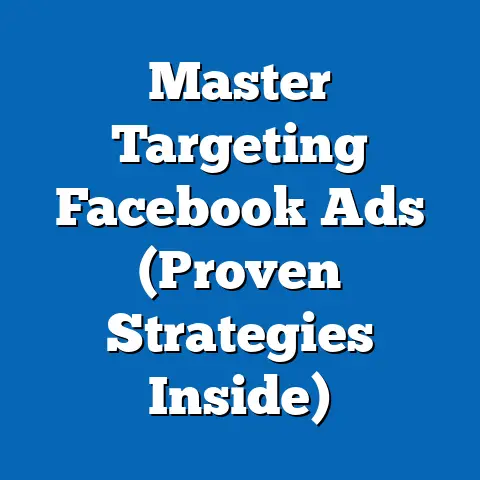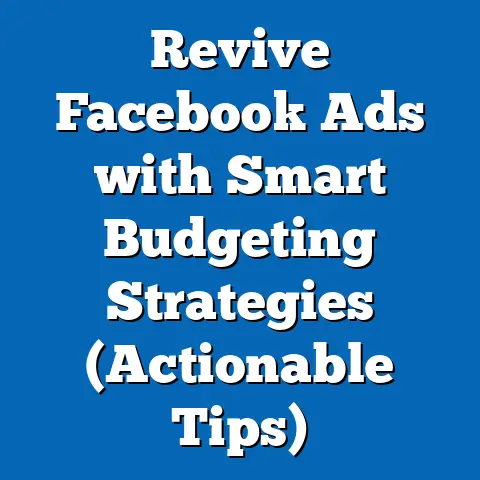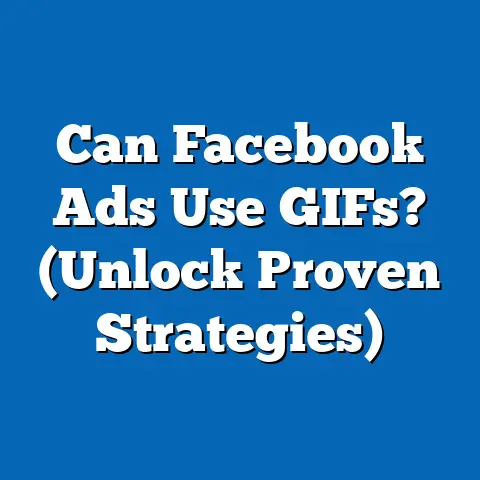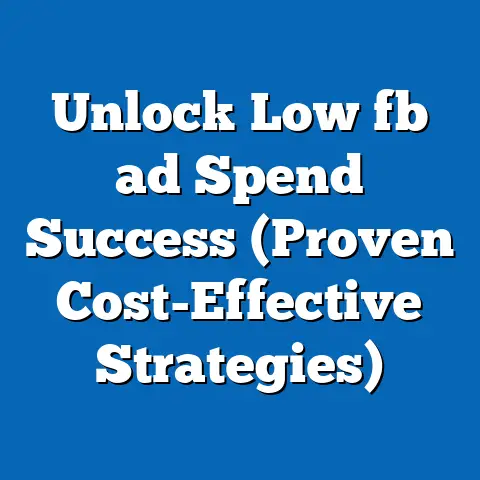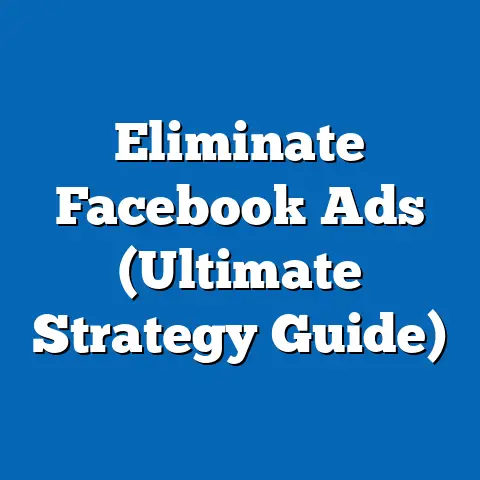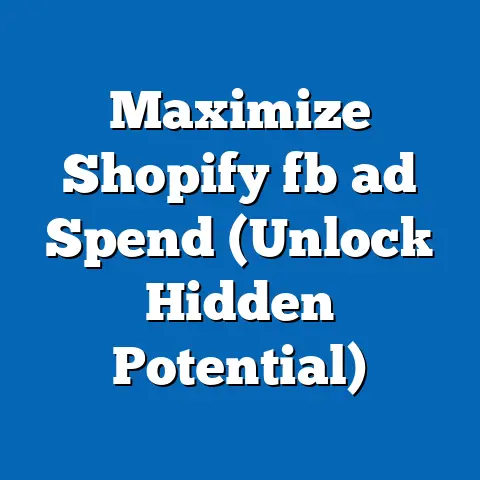Boost Spa Facebook Ads Engagement (Proven Strategies)
The Growing Demand for Spa Services: A Lifestyle Need
Modern life is often synonymous with stress, with many individuals juggling demanding careers, family responsibilities, and personal goals. According to the American Psychological Association (APA), 77% of Americans report experiencing stress that affects their physical health, while 73% note impacts on their mental health (APA Stress in America Survey, 2022). Spa services—ranging from massages to facials to holistic therapies—have emerged as a popular antidote, offering relaxation and a break from daily pressures.
The global spa market reflects this growing need, with industry revenue reaching $105 billion in 2022 and projected to grow at a compound annual growth rate (CAGR) of 5.7% from 2023 to 2030, according to Grand View Research. In the United States alone, the spa industry generated $18.1 billion in revenue in 2022, driven by a surge in demand for wellness-focused services post-pandemic (International Spa Association, 2023).
Demographically, the spa industry appeals to a wide audience, though certain groups stand out. Women aged 25-54 make up the largest segment of spa-goers, accounting for 65% of customers, while men represent a growing share at 35%, up from 29% in 2015 (ISPA Consumer Snapshot, 2022). Millennials and Gen Z are particularly active in this space, with 48% of spa visitors falling in the 18-34 age bracket, driven by a cultural emphasis on self-care and mental health awareness. Geographically, urban dwellers are more likely to frequent spas, with 62% of customers residing in metropolitan areas, compared to 38% in suburban or rural regions.
These trends highlight a clear opportunity for spa businesses to connect with a diverse, wellness-hungry audience. However, standing out in a competitive market requires strategic marketing, and Facebook—with its 2.9 billion monthly active users as of 2023 (Meta Investor Reports)—offers an unparalleled platform to engage potential customers. The challenge lies in crafting ads that not only capture attention but also drive meaningful interactions. Let’s dive into proven strategies to boost spa Facebook ads engagement, supported by data and real-world insights.
Why Facebook Ads Matter for Spas
Facebook remains one of the most powerful advertising platforms for small and medium-sized businesses, including spas. As of 2023, 93% of marketers use Facebook ads to reach their target audience, and the platform accounts for 24.2% of total digital ad spending in the U.S. (eMarketer, 2023). For spas, Facebook’s robust targeting options—based on demographics, interests, and behaviors—make it an ideal tool to reach local customers seeking wellness services.
Engagement, defined as likes, comments, shares, and clicks on ads, is a critical metric for success. High engagement not only increases ad visibility through Facebook’s algorithm but also builds trust and brand awareness. According to Hootsuite’s 2023 Social Media Report, posts with higher engagement rates can reduce cost-per-click (CPC) by up to 50%, making it a cost-effective way to maximize ad performance.
However, achieving strong engagement is no easy feat. The average engagement rate for Facebook ads across industries is just 0.94%, with the beauty and wellness sector slightly higher at 1.2% (WordStream, 2023). Spas must employ targeted strategies to stand out in users’ crowded newsfeeds. Below, we break down proven approaches to enhance engagement, supported by data and actionable tips.
Strategy 1: Craft Compelling Visuals and Copy
The Power of Visual Storytelling
In the wellness industry, visuals are everything. High-quality images and videos of serene spa environments, soothing treatments, and happy clients can evoke an emotional response that text alone cannot achieve. According to Facebook’s own research, ads with visuals generate 65% higher engagement than text-only ads (Meta Business Insights, 2022).
For spas, this means investing in professional photography or short video clips showcasing signature services like massages, facials, or aromatherapy sessions. A study by Socialinsider found that video ads on Facebook have an average engagement rate of 1.84%, compared to 0.87% for static image ads (Socialinsider, 2023). Consider creating 15-30 second videos of a client enjoying a relaxing treatment, paired with calming background music, to draw viewers in.
Writing Copy That Converts
While visuals grab attention, copy seals the deal. Effective ad copy for spas should focus on the emotional benefits of the service—relaxation, stress relief, and self-care—while including a clear call-to-action (CTA). For example, phrases like “Unwind Today—Book Your Massage Now!” or “Treat Yourself to 50% Off Your First Facial!” create urgency and highlight value.
Data from WordStream shows that ads with a clear CTA increase click-through rates (CTR) by 285% compared to ads without one (WordStream, 2023). Additionally, incorporating social proof, such as “Join 500+ Happy Clients!” or featuring a 5-star review, can boost credibility and engagement by 20-30%, according to a 2022 study by HubSpot.
Visualization Idea
Imagine a Facebook carousel ad featuring three images: a tranquil spa room, a close-up of a massage in progress, and a smiling client post-treatment. The accompanying copy reads, “Escape the stress—book your 60-minute massage for just $59 this week! Limited spots available.” This combination of aspirational visuals and a time-sensitive offer can drive clicks and shares.
Strategy 2: Leverage Hyper-Targeted Audiences
Understanding Your Audience
Facebook’s ad platform allows businesses to target users based on location, age, gender, interests, and even life events. For spas, local targeting is key—85% of spa customers visit locations within a 10-mile radius of their home or workplace (ISPA Consumer Snapshot, 2022). Setting a tight geographic radius ensures ads reach those most likely to book an appointment.
Demographic targeting is equally important. As noted earlier, women aged 25-54 are the primary spa audience, but don’t overlook men or younger demographics like Gen Z, who are increasingly prioritizing wellness. Interests such as “yoga,” “meditation,” or “organic skincare” can help refine your audience further.
Custom and Lookalike Audiences
Using custom audiences—based on past customers, website visitors, or email lists—can significantly boost engagement. Facebook data shows that custom audience ads have a 37% higher CTR compared to broad targeting (Meta Business Insights, 2023). For example, retargeting users who visited your spa’s booking page but didn’t complete a purchase can recover lost leads.
Lookalike audiences, which target users similar to your existing customers, are another powerful tool. Spas using lookalike audiences report a 25% increase in ad engagement and a 15% lower CPC, according to a 2022 case study by Social Media Examiner.
Visualization Idea
Picture a targeted ad campaign for a spa in downtown Chicago, set to a 5-mile radius, aimed at women aged 30-45 with interests in “wellness” and “self-care.” The ad offers a “First-Time Client Special: 20% Off Any Service” and appears only to users who match this profile or have previously interacted with the spa’s page. This precision targeting maximizes relevance and engagement.
Strategy 3: Offer Irresistible Promotions and Incentives
The Appeal of Discounts
Price sensitivity plays a significant role in spa bookings, especially for first-time clients. A 2022 survey by Statista found that 68% of consumers are more likely to try a new spa if offered a discount or introductory rate. Limited-time offers, such as “Book This Week for 30% Off!” or “Buy One, Get One 50% Off,” create urgency and encourage immediate action.
Bundling services is another effective tactic. For instance, offering a “Relaxation Package” with a massage, facial, and complimentary tea for a discounted rate can increase perceived value. Data from the ISPA shows that 42% of spa-goers opt for packages over standalone services when discounts are involved (ISPA Consumer Snapshot, 2022).
Contests and Giveaways
Running a contest or giveaway on Facebook can skyrocket engagement. For example, asking users to “Comment your favorite self-care tip for a chance to win a free 60-minute massage!” can generate likes, comments, and shares. According to Tailwind’s 2023 Social Media Report, posts with giveaways see engagement rates up to 3.5 times higher than standard content.
Visualization Idea
Envision a Facebook ad promoting a “Spa Day Giveaway” where users must like the post, follow the spa’s page, and tag a friend to enter. The prize is a $100 spa gift card, and the ad copy reads, “Pamper yourself or a loved one! Enter now—contest ends in 48 hours.” This format leverages social interaction to amplify reach organically.
Strategy 4: Utilize User-Generated Content and Testimonials
Building Trust Through Authenticity
User-generated content (UGC), such as client photos or reviews shared on social media, is a goldmine for engagement. Consumers trust UGC 50% more than brand-created content, and ads featuring real customer stories see a 4x higher CTR (Stackla, 2022). For spas, this could mean reposting a client’s Instagram story of their relaxing massage experience (with permission) or showcasing before-and-after photos of a skincare treatment.
Testimonials are equally impactful. A short video or quote from a satisfied customer—“I felt like a new person after my facial at [Spa Name]!”—can humanize your brand and build credibility. According to BrightLocal’s 2023 Consumer Review Survey, 79% of consumers trust online reviews as much as personal recommendations.
Encouraging UGC Participation
Spas can actively encourage UGC by inviting clients to share their experiences with a branded hashtag, such as #RelaxAt[YourSpaName]. Offering a small incentive, like 10% off their next visit for posting a review, can increase participation. Data from Yotpo shows that businesses with UGC campaigns see a 20% uplift in engagement rates (Yotpo, 2023).
Visualization Idea
Imagine a Facebook ad featuring a collage of client-submitted photos enjoying spa services, captioned with “See why our clients love us! Share your #SpaMoments for a chance to be featured and win a free session.” This approach combines UGC with a call to action, driving both engagement and brand loyalty.
Strategy 5: Optimize Posting Times and Frequency
Timing Is Everything
When an ad is posted can be just as important as its content. According to Sprout Social’s 2023 Social Media Report, the best times to post on Facebook for maximum engagement are weekdays between 9 a.m. and 1 p.m., with Tuesday and Wednesday showing the highest activity. For spas, aligning ad posts with times when potential clients are planning their day or week—such as early morning or late afternoon—can improve visibility.
Balancing Frequency
Posting too often can lead to ad fatigue, while posting too infrequently risks losing audience attention. Facebook recommends a frequency cap of 2-3 ad impressions per user per week to avoid overexposure (Meta Business Help Center, 2023). Monitoring engagement metrics in Facebook Ads Manager can help spas adjust frequency based on audience response.
Visualization Idea
Consider scheduling a series of ads to run on Tuesday mornings at 10 a.m., targeting local users with a “Midweek Reset: 15% Off Any Service” offer. The ad frequency is set to two impressions per user over three days, ensuring visibility without overwhelming the audience. This strategic timing can capture users during peak engagement windows.
Strategy 6: Use Interactive Ad Formats
Polls, Quizzes, and Stories
Interactive ad formats, such as polls or quizzes, can significantly boost engagement by encouraging active participation. For example, a poll asking, “What’s your go-to stress reliever: Massage or Facial?” invites users to comment and share their preferences. According to Socialbakers, interactive posts achieve 2.5 times more engagement than standard ads (Socialbakers, 2023).
Facebook Stories Ads are another underutilized format for spas. With 500 million daily active users viewing Stories, this format offers a full-screen, immersive experience (Meta, 2023). A short Story ad showcasing a quick spa tour or a limited-time offer can capture attention in a casual, authentic way.
Lead Generation Forms
Facebook’s lead generation ads, which include pre-filled forms for users to request more information or book appointments, are particularly effective for spas. These ads reduce friction in the booking process, with businesses reporting a 20% higher conversion rate compared to standard link ads (Meta Business Insights, 2022).
Visualization Idea
Picture a Facebook poll ad asking, “What’s your ideal spa day: Relaxation or Rejuvenation?” with a follow-up link to book a tailored package. Alternatively, a Stories ad featuring a 10-second clip of a bubbling hot tub with text overlay—“Escape today! Tap to book”—can drive quick engagement and bookings.
Historical Trends vs. Current Data: Evolution of Spa Marketing on Facebook
Looking back, spa marketing on Facebook has evolved significantly over the past decade. In 2015, most spas relied on organic posts to build a following, with paid ads accounting for just 10% of their social media budget (ISPA Digital Marketing Report, 2015). Engagement rates for organic content were higher then, averaging 5-7%, due to less competition and simpler algorithms (Socialbakers, 2015).
Today, the landscape is different. Organic reach has plummeted to an average of 2.2% for business pages, while paid ads dominate, with 80% of spas allocating significant budgets to Facebook advertising (ISPA Digital Marketing Report, 2023). Engagement rates for ads have stabilized at around 1.2% in the wellness sector, reflecting increased competition but also more sophisticated targeting tools.
This shift underscores the importance of adapting to current trends. Where once a simple post about a new service might have garnered likes and shares, today’s spas must invest in visually stunning, highly targeted, and interactive ads to achieve similar results. The rise of video content and Stories, alongside advanced audience segmentation, offers new opportunities to connect with customers in meaningful ways.
Demographic Patterns in Spa Ad Engagement
Engagement with spa ads on Facebook varies significantly by demographic. Women aged 25-44 consistently show the highest interaction rates, with a CTR of 2.1%, compared to 1.5% for men in the same age group (WordStream, 2023). Younger users (18-24) are more likely to engage with Stories and interactive content, while older users (45-64) respond better to promotions and testimonials.
Geographic differences also play a role. Urban users engage with spa ads at a rate of 1.8%, compared to 1.1% for rural users, likely due to greater access to services and higher disposable income (Meta Business Insights, 2023). Seasonal patterns emerge as well, with engagement peaking in November and December (up 30%) as users seek holiday gifts or stress relief (ISPA Consumer Snapshot, 2022).
Understanding these patterns allows spas to tailor their ad strategies. For instance, targeting younger urban women with Stories ads in late fall could yield optimal results, while focusing on older demographics with discount-driven carousel ads might work better year-round.
Conclusion: Broader Implications and Future Trends
Boosting spa Facebook ads engagement is not just about increasing clicks or likes—it’s about building lasting connections with a wellness-focused audience in an increasingly competitive digital space. By leveraging compelling visuals, hyper-targeted audiences, irresistible promotions, user-generated content, optimal timing, and interactive formats, spas can drive meaningful interactions that translate into bookings and loyalty. The data is clear: businesses that prioritize engagement see lower ad costs, higher conversion rates, and stronger brand trust.
Looking ahead, several trends are poised to shape the future of spa marketing on Facebook. The growing emphasis on video content, with platforms like Reels gaining traction, suggests that spas must continue to invest in dynamic, short-form storytelling. Additionally, as privacy regulations evolve, first-party data (such as customer emails and website interactions) will become even more critical for effective targeting. Finally, the integration of AI-driven ad tools could help spas optimize campaigns in real-time, further enhancing engagement.
For spa owners and marketers, the takeaway is simple yet powerful: adapt, experiment, and focus on the customer experience. In a world where self-care is no longer a luxury but a necessity, connecting with your audience through authentic, engaging Facebook ads can set your spa apart and ensure long-term success.

